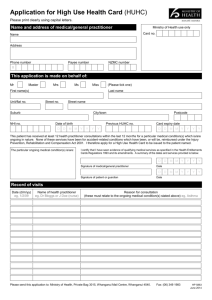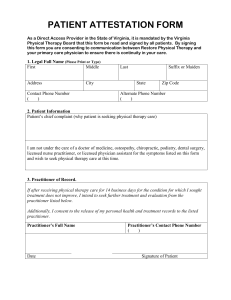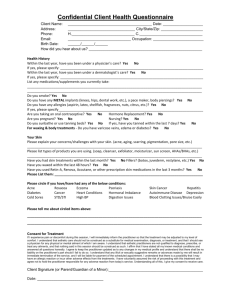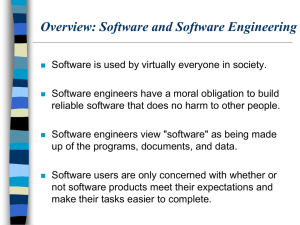Student Outcomes Assessment Plan for Early Childhood Education BA program... 1. Assessment Philosophy:
advertisement
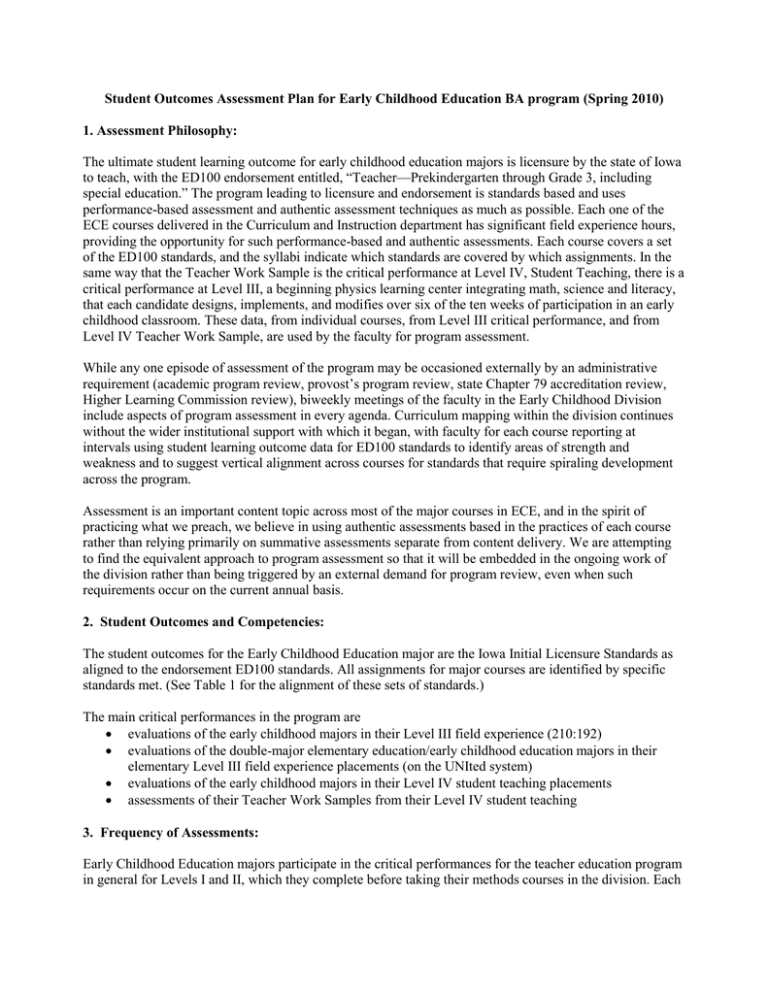
Student Outcomes Assessment Plan for Early Childhood Education BA program (Spring 2010) 1. Assessment Philosophy: The ultimate student learning outcome for early childhood education majors is licensure by the state of Iowa to teach, with the ED100 endorsement entitled, “Teacher—Prekindergarten through Grade 3, including special education.” The program leading to licensure and endorsement is standards based and uses performance-based assessment and authentic assessment techniques as much as possible. Each one of the ECE courses delivered in the Curriculum and Instruction department has significant field experience hours, providing the opportunity for such performance-based and authentic assessments. Each course covers a set of the ED100 standards, and the syllabi indicate which standards are covered by which assignments. In the same way that the Teacher Work Sample is the critical performance at Level IV, Student Teaching, there is a critical performance at Level III, a beginning physics learning center integrating math, science and literacy, that each candidate designs, implements, and modifies over six of the ten weeks of participation in an early childhood classroom. These data, from individual courses, from Level III critical performance, and from Level IV Teacher Work Sample, are used by the faculty for program assessment. While any one episode of assessment of the program may be occasioned externally by an administrative requirement (academic program review, provost’s program review, state Chapter 79 accreditation review, Higher Learning Commission review), biweekly meetings of the faculty in the Early Childhood Division include aspects of program assessment in every agenda. Curriculum mapping within the division continues without the wider institutional support with which it began, with faculty for each course reporting at intervals using student learning outcome data for ED100 standards to identify areas of strength and weakness and to suggest vertical alignment across courses for standards that require spiraling development across the program. Assessment is an important content topic across most of the major courses in ECE, and in the spirit of practicing what we preach, we believe in using authentic assessments based in the practices of each course rather than relying primarily on summative assessments separate from content delivery. We are attempting to find the equivalent approach to program assessment so that it will be embedded in the ongoing work of the division rather than being triggered by an external demand for program review, even when such requirements occur on the current annual basis. 2. Student Outcomes and Competencies: The student outcomes for the Early Childhood Education major are the Iowa Initial Licensure Standards as aligned to the endorsement ED100 standards. All assignments for major courses are identified by specific standards met. (See Table 1 for the alignment of these sets of standards.) The main critical performances in the program are evaluations of the early childhood majors in their Level III field experience (210:192) evaluations of the double-major elementary education/early childhood education majors in their elementary Level III field experience placements (on the UNIted system) evaluations of the early childhood majors in their Level IV student teaching placements assessments of their Teacher Work Samples from their Level IV student teaching 3. Frequency of Assessments: Early Childhood Education majors participate in the critical performances for the teacher education program in general for Levels I and II, which they complete before taking their methods courses in the division. Each of the methods courses includes formative and summative assessment for the specific standards assigned to each course and each course has identified one or more critical performances that cover more than one standard. (See Table 2 for an example from the ECE Curriculum course). At this time, the contribution of these course-based assessments to program assessment is primarily informal, between faculty members who send to or receive from each other’s sequenced courses at the end of each term, either in a division faculty meeting or by meeting in dyads. Although informal, this process has resulted in a good deal of data-based course revision to reduce redundancy and identify holes to fill in the program. Course assessments, including the Level III critical performances, and student teaching assessments, including the Teacher Work Sample, are every term. In the past when sufficient resources of money, personnel, and access have been made available, graduates of the program have been surveyed. Occasionally individual faculty members have carried out research projects in which data have been useful for program assessment, but time constraints and individual priorities make this form of assessment unlikely to become a part of an ongoing assessment plan. Data from critical performances at the program level generally are evaluated in the context of an external demand for program review, but since these have occurred annually in the current four-year period, this has become an annual review. 4. Assessment Methods: Critical performances in each course are documented by the students and assessed by the faculty member using a variety of methods, including rubrics or other scoring criteria for written documentation, and checklists or rating scales for observations of performance-based assignments. Critical performances at the program level each have their own assessments: early childhood majors in their Level III field experience (210:192) course grade based on a variety of criteria, including a rating scale for ED100 standards met filled out by the host teacher at the participation site after 10 weeks of participation double-major elementary education/early childhood education majors rated by their elementary Level III field experience placement cooperating teacher on the UNIted system evaluations of the early childhood majors in their Level IV student teaching placements Level IV student teaching Teacher Work Samples scored by ECE faculty and discussed at a division meeting each term and scores from all ECE majors on the UNIted system 5. Methods of Evaluating and Interpreting Results: Critical performances for each course are evaluated at the end of each course by individual faculty members, or by teams if a course is taught by more than one faculty member, and used for data-based instructional decision-making to make changes in a course to better support student mastery of the standards assigned to that course. Data from critical performances at the program level generally are evaluated in the context of an external demand for program review, with particular attention to the purposes of each review. Biweekly division meetings include program review items on each agenda until data have been collected and shared and discussed and reviews have been submitted. ED100 standards that are shown to be insufficiently covered will be targeted for closer attention, including covering them across courses, or changing assignments to meet them more effectively. Table 1 Alignment of Standards for Standards-based Assessment in ECE program Iowa Unified ECE/ECSE Endorsement (ED100) “Teacher—Prekindergarten through Grade Three, Including Special Education” http://www.state.ia.us/boee/addition.html Iowa Renaissance Licensure/Interstate New Teacher Assessment & Support Consortium (INTASC) Standards http://www.uni.edu/teached/__downloads/INTASCstandards.pdf (2008, January) (1) Child growth and development. XXXXXXXXXXXXXXX 1.Understand the nature of child growth and development for infants and toddlers (birth through age 2), preprimary (age 3 through age 5) and primary school children (age 6 through age 8), both typical and atypical, in areas of cognition, language development, physical motor, social-emotional, aesthetics, and adaptive behavior. 1. STUDENT LEARNING: The practitioner understands how students learn and develop and provides learning opportunities that support intellectual, career, social and personal development. 2. DIVERSE LEARNERS: The practitioner understands how students differ in their approaches to learning and creates instructional opportunities that are equitable and are adaptable to diverse learners. 1. STUDENT LEARNING: The practitioner understands how students learn and develop and provides learning opportunities that support intellectual, career, social and personal development. 2. DIVERSE LEARNERS: The practitioner understands how students differ in their approaches to learning and creates instructional opportunities that are equitable and are adaptable to diverse learners. 2. DIVERSE LEARNERS: The practitioner understands how students differ in their approaches to learning and creates instructional opportunities that are equitable and are adaptable to diverse learners. 3. INSTRUCTIONAL PLANNING: The practitioner plans instruction based upon knowledge of subject matter, students, the community, curriculum goals and state curriculum models. 9. COLLABORATION, ETHICS AND RELATIONSHIPS: The practitioner fosters relationships with parents, school colleagues, and organizations in the larger community to support students' learning and development. 2.Understand individual differences in development and learning including risk factors, developmental variations and developmental patterns of specific disabilities and special abilities. 3.Recognize that children are best understood in the contexts of family, culture and society and that cultural and linguistic diversity influences development and learning. (2) Developmentally appropriate learning environment and curriculum implementation. XXXXXXXXXXXXXXXXX 1.Establish learning environments with social support, from the teacher and from other students, for all children to meet their optimal potential, with a climate characterized by mutual respect, encouraging and valuing the efforts of all regardless of proficiency. 1. STUDENT LEARNING: The practitioner understands how students learn and develop and provides learning opportunities that support intellectual, career, social and personal development. 2. DIVERSE LEARNERS: The practitioner understands how students differ in their approaches to learning and creates instructional opportunities that are equitable and are adaptable to diverse learners. 5. LEARNING ENVIRONMENT/ CLASSROOM MANAGEMENT: The practitioner uses an understanding of individual and group motivation and behavior to create a learning environment that encourages positive social interaction, active engagement in learning, and self-motivation. 9. COLLABORATION, ETHICS AND RELATIONSHIPS: The practitioner fosters relationships with parents, school colleagues, and organizations in the larger community to support students' learning and development. 2.Appropriately use informal and formal assessment to monitor development of children and to plan and evaluate curriculum and teaching practices to meet individual needs of children and families. 3.Plan, implement, and continuously evaluate developmentally and individually appropriate curriculum goals, content, and teaching practices for infants, toddlers, preprimary and primary children based on the needs and interests of individual children, their families and community. 4.Use both child-initiated and teacher-directed instructional methods, including strategies such as small and large group projects, unstructured and structured play, systematic instruction, group discussion and cooperative decision making. 5.Develop and implement integrated learning experiences for home-, center- and school-based environments for infants, toddlers, preprimary and primary children: ·Develop and implement integrated learning experiences that facilitate cognition, communication, social and physical development of infants and toddlers within the context of parentchild and caregiver-child relationships. ·Develop and implement learning experiences for preprimary and primary children with focus on multicultural and nonsexist content that includes development of responsibility, aesthetic and artistic development, physical development and well-being, cognitive development, and emotional and social development. ·Develop and implement learning experiences for infants, toddlers, preprimary, and primary children with a focus on language, mathematics, science, social studies, visual and expressive arts, social skills, higher-thinking skills, and developmentally appropriate methodology. ·Develop adaptations and accommodations for infants, toddlers, preprimary, and primary aged children to meet their individual needs. 6.Adapt materials, equipment, the environment, programs and use of human resources to meet social, cognitive, physical motor, communication, and medical needs of children and diverse learning needs. (3) Health, safety and nutrition. 1.Design and implement physically and 7. ASSESSMENT: The practitioner understands and uses formal and informal assessment strategies to evaluate the continuous intellectual, social and physical development of the learner. 3. INSTRUCTIONAL PLANNING: The practitioner plans instruction based upon knowledge of subject matter, students, the community, curriculum goals and state curriculum models. 4. INSTRUCTIONAL STRATEGIES: The practitioner understands and uses a variety of instructional strategies to encourage students' development of critical thinking, problem solving, and performance skills. 1. STUDENT LEARNING: The practitioner understands how students learn and develop and provides learning opportunities that support intellectual, career, social and personal development. 2. DIVERSE LEARNERS: The practitioner understands how students differ in their approaches to learning and creates instructional opportunities that are equitable and are adaptable to diverse learners. 3. INSTRUCTIONAL PLANNING: The practitioner plans instruction based upon knowledge of subject matter, students, the community, curriculum goals and state curriculum models. 2. DIVERSE LEARNERS: The practitioner understands how students differ in their approaches to learning and creates instructional opportunities that are equitable and are adaptable to diverse learners. XXXXXXXXXXXXXXXX 5. LEARNING ENVIRONMENT/CLASSROOM psychologically safe and healthy indoor and outdoor environments to promote development and learning. 2.Promote nutritional practices that support cognitive, social, cultural and physical development of young children. 3.Implement appropriate appraisal and management of health concerns of young children including procedures for children with special health care needs. 4.Recognize signs of emotional distress, physical and mental abuse and neglect in young children and understand mandatory reporting procedures. 5.Demonstrate proficiency in infant-child cardiopulmonary resuscitation, emergency procedures and first aid. MANAGEMENT: The practitioner uses an understanding of individual and group motivation and behavior to create a learning environment that encourages positive social interaction, active engagement in learning, and self-motivation. 2. DIVERSE LEARNERS: The practitioner understands how students differ in their approaches to learning and creates instructional opportunities that are equitable and are adaptable to diverse learners. 9. COLLABORATION, ETHICS AND RELATIONSHIPS: The practitioner fosters relationships with parents, school colleagues, and organizations in the larger community to support students' learning and development. 4. INSTRUCTIONAL STRATEGIES: The practitioner understands and uses a variety of instructional strategies to encourage students' development of critical thinking, problem solving, and performance skills. (4) Family and community collaboration. XXXXXXXXXXXXXXX 1.Apply theories and knowledge of dynamic roles and relationships within and between families, schools, and communities. 4.Use communication, problem-solving and helpgiving skills in collaboration with families and other professionals to support the development, learning and well-being of young children. 5.Participate as an effective member of a team with other professionals and families to develop and implement learning plans and environments for young children. 8. FOUNDATIONS, REFLECTION AND PROFESSIONAL DEVELOPMENT: The practitioner continually evaluates the effects of the practitioner's choices and actions on students, parents, and other professionals in the learning community, and actively seeks out opportunities to grow professionally. 9. COLLABORATION, ETHICS AND RELATIONSHIPS: The practitioner fosters relationships with parents, school colleagues, and organizations in the larger community to support students' learning and development. 9. COLLABORATION, ETHICS AND RELATIONSHIPS: The practitioner fosters relationships with parents, school colleagues, and organizations in the larger community to support students' learning and development. 9. COLLABORATION, ETHICS AND RELATIONSHIPS: The practitioner fosters relationships with parents, school colleagues, and organizations in the larger community to support students' learning and development. 9. COLLABORATION, ETHICS AND RELATIONSHIPS: The practitioner fosters relationships with parents, school colleagues, and organizations in the larger community to support students' learning and development. 9. COLLABORATION, ETHICS AND RELATIONSHIPS: The practitioner fosters relationships with parents, school colleagues, and organizations in the larger community to support students' learning and development. (5) Professionalism. XXXXXXXXXXXXXXXX 1.Understand legislation and public policy that affect all young children, with and without disabilities, and their families. 9. COLLABORATION, ETHICS AND RELATIONSHIPS: The practitioner fosters relationships with parents, school colleagues, and organizations in the larger community to support students' learning and development. 8. FOUNDATIONS, REFLECTION AND PROFESSIONAL DEVELOPMENT: The practitioner continually evaluates the effects of the practitioner's choices and actions on students, parents, and other professionals in the learning community, and 2.Assist families in identifying resources, priorities, and concerns in relation to the child's development. 3.Link families, based on identified needs, priorities and concerns, with a variety of resources. 2.Understand legal aspects, historical, philosophical, and social foundations of early childhood education and special education. 3.Understand principles of administration, organization and operation of programs for children aged birth to 8 and their families, including staff and program development, supervision and evaluation of staff, and continuing improvement of programs and services. 4.Identify current trends and issues of the profession to inform and improve practices and advocate for quality programs for young children and their families. 5.Adhere to professional and ethical codes. 6.Engage in reflective inquiry and demonstration of professional self-knowledge. actively seeks out opportunities to grow professionally. 9. COLLABORATION, ETHICS AND RELATIONSHIPS: The practitioner fosters relationships with parents, school colleagues, and organizations in the larger community to support students' learning and development. 8. FOUNDATIONS, REFLECTION AND PROFESSIONAL DEVELOPMENT: The practitioner continually evaluates the effects of the practitioner's choices and actions on students, parents, and other professionals in the learning community, and actively seeks out opportunities to grow professionally. 9. COLLABORATION, ETHICS AND RELATIONSHIPS: The practitioner fosters relationships with parents, school colleagues, and organizations in the larger community to support students' learning and development. 8. FOUNDATIONS, REFLECTION AND PROFESSIONAL DEVELOPMENT: The practitioner continually evaluates the effects of the practitioner's choices and actions on students, parents, and other professionals in the learning community, and actively seeks out opportunities to grow professionally. 8. FOUNDATIONS, REFLECTION AND PROFESSIONAL DEVELOPMENT: The practitioner continually evaluates the effects of the practitioner's choices and actions on students, parents, and other professionals in the learning community, and actively seeks out opportunities to grow professionally. (6) Prestudent teaching field experiences. Complete 100 clock hours of prestudent teaching field experience with three age levels in infant and toddler, preprimary and primary programs and in different settings, such as rural and urban, encompassing differing socio-economic status, ability levels, cultural and linguistic diversity and program types and sponsorship. (7) Student teaching. Complete a supervised student teaching experience of at least 12 weeks total in at least two different settings in two of three age levels: infant and toddler, preprimary, primary and with children with and without disabilities. 8. FOUNDATIONS, REFLECTION AND PROFESSIONAL DEVELOPMENT: The practitioner continually evaluates the effects of the practitioner's choices and actions on students, parents, and other professionals in the learning community, and actively seeks out opportunities to grow professionally. 10. COMPUTER APPLICATION: The practitioner understands and uses a variety of computer applications to encourage students' development of critical thinking, problem solving, and performance skills. Table 2 Critical Performance in ECE Curriculum course The Curriculum Project is the culminating activity for the 210:151 Early Childhood Curriculum Development and Organization course. This project addresses many of the ED100 teaching standards. Examples of how the project demonstrates progress toward the standards can be found in one of the curriculum projects submitted in the fall 2009 semester. This project is typical of the projects submitted every semester. ED100 STANDARD EXAMPLES OF STUDENT WORK ADDRESSING THE STANDARD 1.2 Understands individual differences in Pages 1-6 development and learning including risk factors, multiple intelligences, Each student creates an imaginary child developmental variations, and with a specific disability. The student developmental patterns of specific researches the disability and then describes disabilities and special abilities. this imaginary child, including strengths, limitations, likes and dislikes. The student must also describe any accommodations or modifications that will be made in the classroom so the imaginary child can fully participate in the curriculum 2.2 Uses informal and formal assessment Pages 14-34 (assessment sections for each to effectively monitor children's lesson plan) development, and plans and evaluates curriculum and teaching practices to meet Pages 36-123 (for each activity in each the individual needs of children and their learning center the student describes families. appropriate assessment) 2.3 Plans, implements, and continuously evaluates developmentally and individually appropriate curriculum goals, content, and teaching practices for children 0-8 based on the strengths, needs, and interests of individual children, their families, and the community. 2.4 Uses both child-initiated and teacherdirected instructional methods including strategies such as small and large group projects, unstructured and structured play, systematic instruction, group discussion, and cooperative decision making. 2.6 Adapts materials, equipment, the environment, programs, and human resources to meet the social, cognitive, physical-motor, communicative, and All lessons, learning centers, activities and assessments must take into consideration the needs of the imaginary children created by the students. Pages 14-123 Students plan teacher-directed large group lessons that are structured around literacy. In addition the students plan five learning centers. The centers allow for a combination of guided activities and childinitiated activities. Pages 36-123 For each learning center, the student completes an adaptations checklist to indicate what support the imaginary child medical needs of children with diverse learning needs. 4.5 Participates as an effective member of a team with other professionals, paraprofessionals, volunteers, and families to develop and implement learning plans and environments for young children with disabilities would need in order to fully participate in that center The curriculum project is designed so that the students must work as a group to design the curriculum for their virtual class. The virtual class consists of one imaginary child with a disability and one imaginary typically developing preoperational child for each student in the group. The group designs and equips an imaginary classroom, creates a context for their classroom, selects a topic that is appropriate for the classroom, and plans large group lessons and learning centers to fit the topic.


